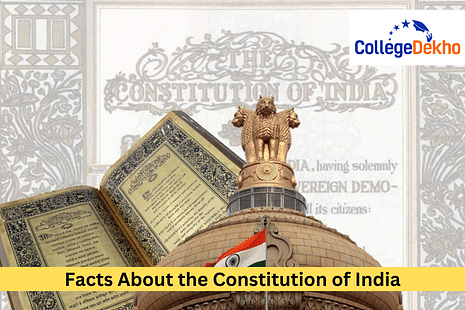If you are a law aspirant and want to know Facts about the Constitution of India, give this article a read. It will provide all the important facts about the Constitution of India that every law aspirant must be aware of.

The Constitution of India is vast and has many aspects that every Indian citizen should be aware of. The Indian Constitution is the world's longest and most thorough constitution. Every candidate who wants to become a lawyer should know the facts about the Constitution of India extremely well as it forms the basis of their education and profession. Given the vastness of the Constitution of India, it is understandable that students cannot possibly memorise every page by heart and produce citations whenever necessary. However, there are certain parts of the constitution of which every individual who wishes to practise law in India and make a career in law must have deep knowledge.
This article contains some important aspects and parts of the Constitution of India that every law aspirant must know. There are interesting facts about the constitution along with the details of some articles and sections. The students who are planning to pursue higher education in the field of law must go through this article to get an idea of the facts about the Constitution of India.

Facts About the Constitution of India
People who are interested in studying law or making a career in law can check here some interesting facts about the Constitution of India.
- The Constitution of India is the longest and the most voluminous constitution in the world.
- The Preamble of the Indian Constitution was inspired by the Preamble and Constitution of the United States of America.
- The original copies of the Indian Constitution were not typed or printed. They were handwritten and are now kept in a helium-filled case in the library of the Parliament.
- Prem Bihari Narain Raizada had written the original copies of the Constitution of India.
- The fundamental rights that are recognised by the Constitution of India were adopted from the fundamental rights of the American Constitution.
- A total of 283 members of the constituent assembly had signed the original Constitution of India.
- The Constitution of India is one of the best and most honoured constitutions in the world.
- The concept of the five-year plan was taken from the concept of the five planning commissions of the Soviet Union or the USSR (Union of Soviet Socialist Republics).
- There are still about 2.18 crore cases that are pending in the distinct and high courts of India.
- There are almost 22.2 million people under Trial in India which is more than the total population of the Netherlands.
- Originally, the Constitution of India was written in English and Hindi.
- The English version of the Indian Constitution has 1,17,369 words.
- Every page of the Constitution of India was decorated by artists from Shantiniketan.
- The Constituent Assembly had met for the first time on 9 December 1946.
- Writing the Constitution of India and completing it took almost three years.
- There were 2,000 amendments that were made in the first draft of the Constitution of India.
- The final draft of the Indian Constitution was ready on 26 November 1949.
- The Constitution of India was signed on 24 January 1950.
- The Constitution of India was legally enforced on 26 January 1950.
- The Indian Constitution has borrowed many things from the constitutions of other countries including Japan, Germany, the USSR, the USA, France, etc.
- As of January 2019, there were only 103 amendments made in the Constitution of India ever since it was enforced.
- The Indian Constitution maintains the principles of equality, fraternity, secularism etc. has been referred to as the ‘Bag of Borrowings’ because it signifies the conglomeration of various provisions taken from different constitutions in the world. However, people often criticise that the Indian Constitution is basically a copy of the provisions. The list of countries constitutions that impacted the Indian Constitution are:
- The United States of America: functions of the president, functions of the vice president, removal of judges from the Supreme and High Courts, judicial review, judiciary independence and fundamental rights.
- Germany: The emergency provisions have been picked up from the German Constitution.
- Ireland: Directive principles, state policies, electing procedure of Presidents, etc.
- Great Britain: Rule of Law, parliamentary type of government, legislative procedure, single citizenship, cabinet system, etc.
- France: Liberty, fraternity and equality like the French Constitution.
- Japan: The Indian Constitution was influenced by the functioning of the Supreme Court.
Facts About the Constitution of India: Important Articles
If you are a law aspirant looking for facts about the Constitution of India, then you should be aware of the important articles that are a part of the Indian Constitution. Law candidates should know that there are 448 articles in 25 parts, 12 schedules, and 5 appendices with more than 100 amendments to the Indian Constitution.
Articles in the Indian Constitution | Subject Mentioned in the Part | Parts of the Indian Constitution |
|---|---|---|
Article 1 - 4 | Union & Its Territory | Part I |
Article 5 - 11 | Citizenship | Part II |
Article 12 - 35 | Fundamental Rights | Part III |
Article 36 - 51 | Directive Principles | Part IV |
Article 51A | Fundamental Duties | Part IV A |
Article 52 - 151 | The Union | Part V |
Article 152 - 237 | The States | Part VI |
- | Note: 7th Amendment Act, 1956 repealed Part 7 | Part VII |
Article 239 - 242 | The Union Territories | Part VIII |
Article 243 - 243O | The Panchayats | Part IX |
Article 243P - 243ZG | The Municipalities | Part IX A |
Article 243ZH - 243ZT | Co-operative Societies | Part IX B |
Scheduled and Tribal Areas | Article 244-244A | Part X |
Article 245 - 263 | Relation between Union & States | Part XI |
Article 264 - 300A | Finance, Property, Contracts and Suits | Part XII |
Article 301 - 307 | Trade, Commerce and Intercourse within the territory of India | Part XIII |
Article 308 - 323 | Services under the Union and States | Part XIV |
Article 323A - 323B | Tribunals | Part XIV A |
Article 324 - 329A | Elections | Part XV |
Article 330 - 342 | Special Provisions relating to certain classes | Part XVI |
Article 343 - 351 | Official Languages | Part XVII |
Article 352 - 360 | Emergency Provisions | Part XVIII |
Article 361 - 367 | Miscellaneous | Part XIX |
Article 368 | Amendment of the Constitution | Part XX |
Article 369 - 392 | Temporary, Transitional and Special Provisions | Part XXI |
Article 393 - 395 | Short title, Commencement, Authoritative Text in Hindi and Repeals | Part XXII |
Also Read:How to Pursue MBA after Law: Benefits, Career Prospects, Best Colleges
Additional Facts About the Indian Constitution
You have already read some of the important facts of the Indian Constitution, but there are some incredible stories about the Constitution that you will be surprised to learn. Dr. B.R. Ambedkar had clarified that he would be the first person to burn the Constitution of India if it did wrong to the minority communities in India.
From the facts discussed above, law aspirants must have understood the speciality of the Indian Constitution. The Constitution is considered one of the most debated documents in the history of India. However, the Constitution of India has also inspired other countries to practise secular government rule.
Stay tuned to CollegeDekho for more information regarding law admissions in India. Students who have any queries and doubts can write to us on our QnA Zone where their problems are solved by our experts.

















Similar Articles
Tips to Prepare for CLAT 2025 Quantitative Techniques Section
Tips to Prepare for English Language Section of CLAT 2025
How to Score 100+ in CLAT 2025?
CLAT 2025: Exam Date (Out), Registration, Pattern, Syllabus, Admit Card, Result
Colleges Accepting CLAT 2025 Scores & Seat Matrix
Private Law Colleges Accepting CLAT Scores